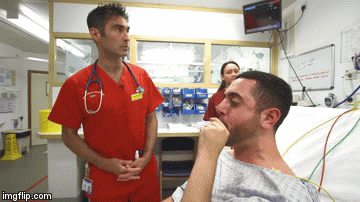Vagal Maneuvers in SVT: Give 'em a Leg Up!
You walk into the start of your shift when the nurse urgently calls you into a room where a new patient has been placed with a heart rate of 240. The patient is alert, oriented, and normotensive but complaining of chest pain that started acutely upon waking up 1 hour ago with palpitations. She then drove herself to the ED. She reports this happening once before about 1 year ago that required "a special IV medicine." This is her EKG:
Clinical question: How should supraventricular tachycardia (SVT) be evaluated in the ED, and how effective are vagal maneuvers in converting SVT to normal sinus rhythm?
Pathophysiology and Clinical Manifestations
SVT can be broken down both by site of origin and regularity. Regular rhythm tachycardias originating from the atria include sinus tachycardia, atrial tachycardia, atrial flutter, and sinus node reentrant tachycardia. Regular rhythm tachycardias originating from the atrioventricular region include atrioventricular nodal reentrant tachycardia (AVNRT), atrioventricular reentrant tachycardia (AVRT), and automatic junctional tachycardia. All the irregular rhythm tachycardias originate from the atria and include atrial fibrillation, atrial flutter with variable block, and multifocal atrial tachycardia. In patients with otherwise healthy hearts, the most common type of paroxysmal (sudden onset) SVT is AVNRT (60%), 30% of SVT have AVRT, and 10% have either atrial tachycardia or sinoatrial nodal tachycardia.
Commonly associated clinical symptoms include lightheadedness, chest pain, syncope/presyncope, polyuria (as atria can become enlarged by not fully ejecting blood, thus releasing atrial natriuretic peptide), shortness of breath, and anxiety. People with pre-existing heart disease, such as CHF or CAD, have increased chance of SVT as both ischemia and stretching of the myocardium increase the risk of arrhythmias. Seventy-five percent of patients with SVT are female.
Management of SVT
When patients present with new palpitations and tachycardia, the first step is to determine stability. If the patient is hypotensive, they need to be treated with synchronized cardioversion immediately. If the patient remains normotensive, with or without the above mentioned symptoms, he or she can be initially treated with vagal maneuvers, as they are less invasive and cause less discomfort than chemical or electrical cardioversion. Vagal maneuvers include carotid sinus massage, facial ice water immersion, and Valsalva maneuver.
Carotid sinus massage involves massaging the base of the internal carotid artery (which is a major baroreceptor in the body) to stimulate the vagus nerve and theoretically decrease heart rate. A 2015 review article shows this procedure is not without risk and reports a 1% neurologic complication rate associated with the maneuver (think knocking off an atherosclerotic plaque into the brain), ranging from mild dysarthria and visual field defects to dense hemiplegia, and as the procedure has shown only modest efficacy at best, the risks may outweigh the benefits [Collins].
A second vagal maneuver is ice water immersion of the face, which stimulates the human diving reflex and acts via the vagal nerve as well to slow heart rate. This method seems to be more effective in younger patients, with some studies showing conversion in as many as 89% of patients under 1 year of age. Its efficacy negatively correlates with increasing age. They keys to effective use of ice water immersion in reversion of PSVT include: complete facial immersion in iced water, or covering the face with an ice pack or cold stimulus of 10*C, for at least 30 s.
Ok now bear down...
There are multiple variations on the Valsalva maneuver, all of which attempt to increase intrathoracic pressure and causing vagal stimulation. This can be as simple as telling a patient to "bear down" as if they are having a bowel movement, having them blow into a straw or syringe, or forcefully cough. A 2015 Cochrane Review showed a range of effectiveness of the Valsalva maneuver. Three studies involving a total of 316 participants were included in this review. Analysis of the results showed that reversion success lies somewhere between 19.4% and 54.3%. Few studies show adverse effects of this maneuver, but it can potentially cause hypotension and syncope.
The 2015 REVERT trial represents biggest recent update in the world of Valsalva literature. The modified Valsalva maneuver is performed by semi-recumbent position patients who produce 40mmHg pressure for 15 seconds and are then repositioned in a supine position with a passive leg raise immediately after the Valsalva strain. The REVERT trial convincingly shows that this modified Valsalva maneuver drastically increases the rate of conversion from SVT to normal sinus rhythm (NSR) within one minute compared to normal Valsalva maneuver without costing any money or adverse affects. To confirm the required intrathoracic pressure, the patients in the study blew into a modified manometer until they achieved 40mmHg for 30 seconds. As this setup is not readily available in all settings, the study also suggested that blowing into a 10mL syringe for 30 seconds achieved comparable intrathoracic pressure. To compare, the normal Valsalva method was successful in converting patients to NSR 17% of the time and the modified Valsalva maneuver converted them 43% of the time, resulting in an absolute difference of 26% and a number needed to treat of 3.8. The modified Valsalva group in the study also required adenosine 19% less often compared to the control group.
Demonstrating modified Valsalva.
If the patient fails to respond to the above mentioned vagal maneuvers, and remains stable in SVT, the next line treatment should involve chemical therapy (e.g. adenosine) before moving to synchronized cardioversion.
Submitted by Trevor Slezak, MD, PGY-2
Edited by Adam Rieves, MD, PGY-3
Faculty reviewed by Phil Chan, MD (@PhilChanEM)
References
Appelboam A, et al. Postural Modification to the Standard Valsalva Manoeuvre for Emergency Treatment of Supraventricular Tachycardias (REVERT): A Randomised Controlled Trial. Lancet 2015. [epub ahead of print] PMID: 26314489
Burns EJ. Supraventricular Tachycardia (SVT). Life in the Fast Lane. 18 March 2017.
Campbell M, Buitrago SR. BET 2: ICE WATER IMMERSION, OTHER VAGAL MANOEUVRES OR ADENOSINE FOR SVT IN CHILDREN. Emerg Med J 2017 34: 58-60
Collins NA, Higgins GL. Reconsidering the effectiveness and safety of carotid sinus massage as a therapeutic intervention in patients with supra ventricular tachycardia. The American Journal of Emergency Medicine. Volume 33, issue 6, pp 807-809. June 2015.
Ganz LI, et al. Clinical manifestations, diagnosis, and evaluation of narrow QRS complex tachycardias. UpToDate. 28 Sep 2016.
Smith GD, et al. The effectiveness of the Valsalva Manouevre for stopping an abnormal heart rhythm. Cochrane Review. 18 February 2015.http://www.cochrane.org/CD009502/VASC_the-effectiveness-of-the-valsalva-manoeuvre-for-stopping-an-abnormal-heart-rhythm
Smith G, Morgans A, Taylor DM, et al. Use of the human dive reflex for the management of supraventricular tachycardia: a review of the literature. Emerg Med J 2012 29: 611-616. March 3, 2012

